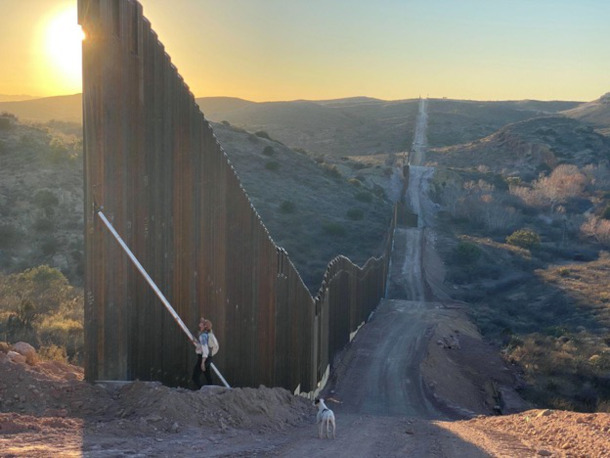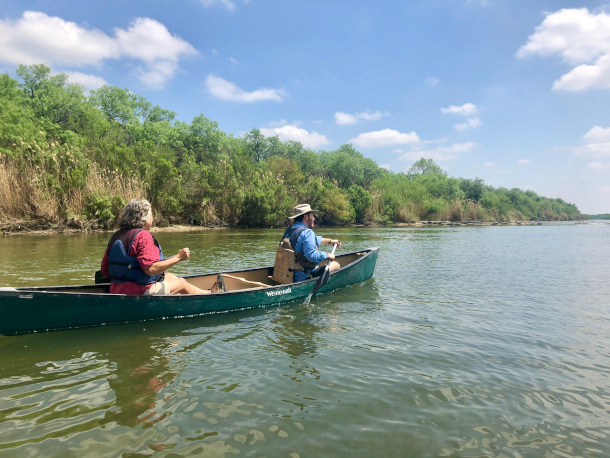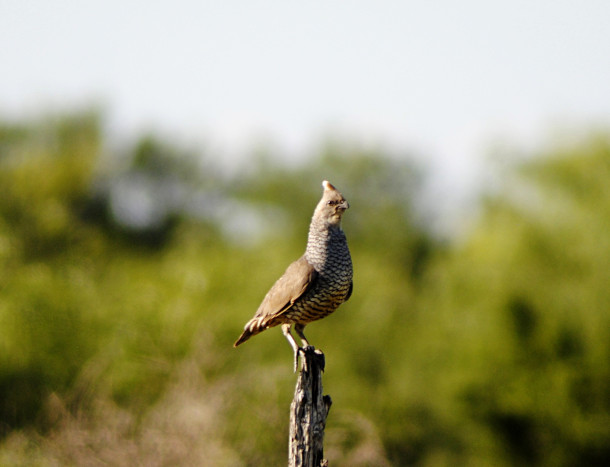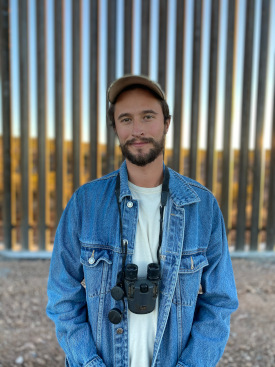Biden Admin Fast-Tracks Border Wall
Air Date: Week of October 20, 2023

During the Trump Administration 458 miles of border wall barriers along Southern Texas were built. According to the U.S. Border Protection the wall consists mostly of 18- to 30-foot steel bollards anchored in concrete. The barriers also feature sensors, lights, cameras and parallel roads in some places. (Photo: Laiken Jordahl, Center for Biological Diversity)
The Biden administration is invoking special powers to waive more than 20 environmental laws so it can fast-track a new section of border wall along the Rio Grande River. The administration claims it is compelled to spend funds appropriated by Congress. Laiken Jordahl of the Center for Biological Diversity joins Host Jenni Doering to voice concerns about the environmental and cultural resources that could be disrupted by the barrier.
Transcript
O’NEILL: From PRX and the Jennifer and Ted Stanley Studios at the University of Massachusetts, Boston this is Living on Earth. I’m Aynsley O’Neill.
DOERING: And I’m Jenni Doering.
Down in southern Texas, the Biden administration is moving ahead with plans to build a nearly 20-mile section of new border wall along the Rio Grande river. And the administration intends to move quickly by invoking special powers to waive 26 federal laws including the Endangered Species Act, the National Environmental Policy Act and others. A 2005 law called the Real ID Act gives the Secretary of Homeland Security the power to waive any laws that could interfere with border barrier construction. President Biden campaigned on the promise that “not another foot” of border wall would be built during his presidency. But now his Administration claims it is compelled to spend money Congress appropriated for border barriers during the Trump presidency. The plans to move ahead with the wall come amid a recent surge in unauthorized border crossings. That has intensified political pressure to fortify the border but opponents say there could be severe environmental consequences. Laiken Jordahl is the Southwest Conservation Advocate at the Center for Biological Diversity and he joins us now from Tucson, Arizona to discuss. Welcome to Living on Earth Laiken!
JORDAHL: Thanks so much for having me.
DOERING: Please describe this Rio Grande area where the border wall is expected to be expanded. What does it look like?
JORDAHL: Yeah, it's a great question. I think it's so important to actually make everyone aware that this is a real place. We hear so much on the news about these big issues around discourse around border issues and immigration. But real people live in these communities. These are real tracts of wildlife refuges. These are people's farmlands, homes that have been in families hands for many, many, many generations. And Starr County, this specific part of the border is one of the most peaceful, serene, beautiful stretches of the border that I've ever been to. And I spent a lot of my last five years basically traveling, every single stretch of border wall, I had the incredible privilege of actually floating down the river in Starr County. We got to spend about five hours in a canoe paddling this stretch of river where these new border walls are planned to go up. And I felt like I was in a national park, I mean, there were these massive Texas cypress trees draped in Spanish moss. The bird life was just mind boggling, we saw Texas green jays, oriels, all sorts of birds that people travel from around the world to see. I mean they were all right there with us in Starr County and these are the exact same areas where the border wall is planning to go up.

Laiken’s partner Maxie and their pup Gunther are inspecting the freshly built wall during the Trump Administration. The concrete was drying that day and the diagonal beam was temporary support left in place while the concrete dries. (Photo: Laiken Jordahl, Center for Biological Diversity)
DOERING: And more elusive, I'm sure but in some areas, there are jaguars that crossed back and forth between the US and Mexico and I don't know other species as well?
JORDAHL: Yeah, absolutely. We just recently got some exciting information that a Jaguar was documented in Arizona, near the border, actually in the same location near the location where our former governor built a wall of shipping containers that was recently decommissioned and taken down. So we have Jaguars we have ocelots, we have all sorts of incredible species. Black bears, Sonoran pronghorn, an incredible diversity of wildlife in the Borderlands, a lot of which are impacted already by existing border walls, and many of which would be further harmed by additional border wall construction, like the plans that Biden is currently moving forward with in Starr County.
DOERING: And how much of the US Mexico border already has border wall along it?
JORDAHL: Yeah, that's a great question at about 700 miles have some sort of barrier along them. And the Trump administration built a huge amount of new and destructive border barriers. There's some semantic issues that people like to get tied up in around whether or not what he did was new border wall construction. But a lot of what Trump did was replace these tiny vehicle barriers that wildlife could pass over or under with massive 30 foot high border walls that stopped wildlife migrations dead in their tracks.
DOERING: Please walk us through some of the environmental protections that the Biden administration is bypassing for this border wall construction?

Laiken Jordahl paddling with friends in the Rio Grande in Starr County. (Photo: Courtesy of the Center for Biological Diversity)
JORDAHL: Yeah. So when we think about environmental laws that protects people, communities and wildlife, you know, these are laws like the Clean Air Act, the Clean Water Act, the Safe Drinking Water Act, the Endangered Species Act. I mean, truly, the Biden administration has cast aside all of our nation's most important environmental laws to build this wall. These laws also protect cultural resources and indigenous interest laws like the Native American Graves Protection and Repatriation Act. I mean, you look at that list of laws that the Biden administration has just cast aside with the stroke of a pen. You know, these are laws that Congress has fought over deliberated on that people have dedicated their lives to passing and now they've just been eviscerated.
DOERING: And why are laws, like the Endangered Species Act or the Clean Air Act important for making sure that projects aren't pushed through too speedily?
JORDAHL: Yeah, so you know, in the case of this specific project, there are two endangered plants listed under the Endangered Species Act that exist in Starr County, that very likely could have populations in the way of this wall construction. By waiving the Endangered Species Act, the Biden administration could allow this project to move forward, they could destroy some of the last populations, the prostrate milkweed, or there's a pot of bladder pod, these two plants that are endemic to this region that don't live anywhere else. So laws, like the Endangered Species Act, ensure that the government consults with expert biologists and makes sure that they do not do any actions that could contribute to the extinction of these rare species. And now with this decision, the Biden administration is ensuring that there is no analysis. So we're extremely concerned about plants like these endemic plants in Starr County.
DOERING: And from your understanding what are the concerns around the cultural resources for local indigenous people that could be impacted by this border wall stretch?

The Scaled Quail is one of the many animals that travel back and forth through Starr County Texas that would be impacted by expansion of the border wall. (Photo: Mike Ostrowski, Flickr, CC BY-SA 2.0)
JORDAHL: Yeah, so It's really important to note that the border region is home to many indigenous tribes and nations. They have been in these regions long before any Europeans ever arrived here long before there was ever a border imposed upon the landscape and indigenous people have really paid the price of our attempts to wall off and militarize the US Mexico border. We had some really shocking information come out recently in a Government Accountability Office report detailing that the Department of Homeland Security actually dynamited indigenous sacred sites and grave sites in Arizona to speed wall construction here. And of course, that was only allowed because the government had waived laws, like the Native American Graves Protection and Repatriation Act. These laws ensure that there is proper consultation with experts, with tribes. And by casting aside these protections, I'm really fearful that we could see similar results from wall construction in Texas.
DOERING: Talk to me about the other people who live in Starr County, how would this new stretch of border wall affect their lives?
JORDAHL: Yeah, so I think it's important to know that Starr County is one of the poorest counties in all of Texas, it is more than 95% Latino, it is by definition, a community where environmental justice issues should be forefront. All of life in the Rio Grande Valley really orbits the river, I mean that's why these communities were established there. The incredible access to nature that you have when you live in one of these communities on the Rio Grande, it's truly special. You know, when I paddled down the stretch of river in Starr County, I saw families picnicking and fishing, people come with their loved ones to relax, to spend time in nature. And by building these border barriers, the Biden administration will be cutting off these communities, not just from the river, but from their access to nature in green spaces. I don't think anyone has a right to rob these poor communities of their access to nature. And especially in Texas, there's very little public land, so these areas along the Rio Grande are really some of the last best places for communities to picnic, to relax, to fish, to play, to swim. And by building these walls, we really will be walling off these poor communities, these vulnerable border communities from their access to nature.
DOERING: How is the Biden administration able to do this to waive these laws and move ahead with this fast track timeline?
JORDAHL: There is a little known provision in a 2006 law called the REAL ID Act, that gives the Secretary of Homeland Security the discretion to waive any and all laws that they want, in order to rush construction of border walls. And ultimately, that's where this waiver authority is coming from. A part of that waiver allows them to waive NEPA, the National Environmental Policy Act, which is essentially the standard that the government uses for any large scale environmental project that could harm public lands or wildlife, or impact neighboring communities. Through that law, there is a very clear framework that requires public scoping, it requires public hearings, it requires analysis. There's a lot of government transparency that we all get to enjoy because of laws, like the National Environmental Policy Act. But now, with these waivers, the people of Starr County are left completely in the dark.

Laiken Jordahl is the Southwest Conservation Advocate for the Center for Biological Diversity. (Photo: Courtesy of the Center for Biological Diversity)
DOERING: The Biden administration has said that it had no choice but to fast track the wall expansion because Congress had already allocated those funds. What's your assessment of that explanation?
JORDAHL: Yeah, so the administration is proceeding as if their hands are tied here and that is just not the truth. There is nothing in the appropriations bill that requires the administration to waive all of our nation's most important environmental laws to build this wall. Even if you agree with the administration's opinion that they must spend this money on these border barriers, there is no justification for stripping these protections from vulnerable border communities, and wildlife. Recently, 120 different organizations sent a letter urging the Biden administration to rescind these waivers to reverse this mistake that they made and restore legal protections to border communities and wildlife.
DOERING: What might the long term ecological costs of this border wall be you say, even 5, 10 or even 20 years down the road?
JORDAHL: So in the immediate term, there's a lot of habitat destruction, there's a huge loss of habitat for wildlife and birds just as a result of all of the bulldozing. In the longer term, we're extremely concerned about the habitat fragmentation impacts of these border walls. Essentially, when you build these walls, you're isolating populations of wildlife on either the north or south side of the barrier. And whenever you isolate a population, you make that entire population more vulnerable to extinction, more vulnerable to genetic inbreeding, to drought, to localized issues, so we are really concerned that the construction of this wall will further contribute to the demise of endangered species and to the extinction crisis at large.
DOERING: Laiken Jordahl is the Southwest Conservation advocate for the Center for Biological Diversity.
DOERING: Thank you so much, Laiken.
JORDAHL: Thanks!
DOERING: We reached out to the White House and Department of Homeland Security for comment but did not hear back in time for broadcast.
Links
Department of Homeland Security’s waiver
El Pais | “Biden Moves to Allow More Border Wall Construction in Midst of Immigration Crisis”
Living on Earth wants to hear from you!
Living on Earth
62 Calef Highway, Suite 212
Lee, NH 03861
Telephone: 617-287-4121
E-mail: comments@loe.org
Newsletter [Click here]
Donate to Living on Earth!
Living on Earth is an independent media program and relies entirely on contributions from listeners and institutions supporting public service. Please donate now to preserve an independent environmental voice.
NewsletterLiving on Earth offers a weekly delivery of the show's rundown to your mailbox. Sign up for our newsletter today!
 Sailors For The Sea: Be the change you want to sea.
Sailors For The Sea: Be the change you want to sea.
 The Grantham Foundation for the Protection of the Environment: Committed to protecting and improving the health of the global environment.
The Grantham Foundation for the Protection of the Environment: Committed to protecting and improving the health of the global environment.
 Contribute to Living on Earth and receive, as our gift to you, an archival print of one of Mark Seth Lender's extraordinary wildlife photographs. Follow the link to see Mark's current collection of photographs.
Contribute to Living on Earth and receive, as our gift to you, an archival print of one of Mark Seth Lender's extraordinary wildlife photographs. Follow the link to see Mark's current collection of photographs.
 Buy a signed copy of Mark Seth Lender's book Smeagull the Seagull & support Living on Earth
Buy a signed copy of Mark Seth Lender's book Smeagull the Seagull & support Living on Earth

